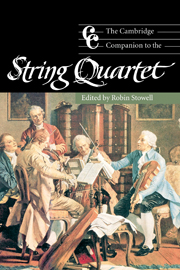2 - Developments in instruments, bows and accessories
from Part I - Social changes and organological developments
Published online by Cambridge University Press: 28 September 2011
Summary
Few of the world's top string players perform in public now a days on instruments made by contemporary luthiers. Most opt instead for antique instruments, especially examples by Antonio Stradivari (1644–1737), Bartolomeo Giuseppe Guarneri del Gesù (1698–1744) or other Italian master luthiers, which they are either sufficiently wealthy to own or fortunate to have on extended loan. This is no recent trend. Rightly or wrongly, it has long been believed that the sound potential of most violins will mature with age and playing.
There is naturally good reason for the esteem in which both Stradivari and Guarneri have been held, even though during their lifetime the tonal qualities of the highly arched models of the Amati family and the Austrian Jacob Stainer (?1617–83) generally held favour. The instruments developed by Stradivari, Guarneri and their contemporaries began to reign supreme only after they, in company with most other extant instruments of the violin family, had been subjected to various external and internal modifications towards the end of the eighteenth century, to make them more responsive to changes in musical style and taste. These modifications occurred between c. 1760 and c. 1830 as a response to the demand for greater tonal sonority, volume and projection, resulting from the increasing vogue for public concerts discussed in Chapter 1. Developments in bow construction at about the same time led to the standardisation (c. 1785) of bow design, measurements, weights and materials by François Tourte (1747–1835).
- Type
- Chapter
- Information
- The Cambridge Companion to the String Quartet , pp. 19 - 38Publisher: Cambridge University PressPrint publication year: 2003

